
|
Keywords: Orion, deep field
 Alnitak, Alnilam, Mintaka
Alnitak, Alnilam, Mintaka
22.11.2017
Alnitak, Alnilam, and Mintaka, are the bright bluish stars from east to west (lower right to upper left) along the diagonal in this cosmic vista. Otherwise known as the Belt of Orion, these three blue supergiant stars are hotter and much more massive than the Sun.
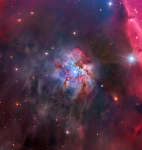 NGC 2023 in the Horsehead s Shadow
NGC 2023 in the Horsehead s Shadow
28.03.2018
Carved by a bright young star in Orion's dusty molecular clouds, NGC 2023 is often overlooked in favor of the nearby dramatic silhouette of the Horsehead Nebula. In its own right it is seen as a beautiful star forming emission and reflection nebula though, a mere 1500 light-years distant.
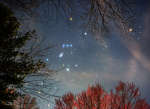 Orion Spring
Orion Spring
25.03.2015
As spring comes to planet Earth's northern hemisphere, familiar winter constellation Orion sets in early evening skies and budding trees frame the Hunter's stars. The yellowish hue of cool red supergiant Alpha Orionis, the great star Betelgeuse, mingles with the branches at the top of this colorful skyscape.
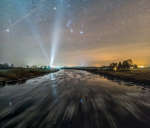 A Cold River to Orion
A Cold River to Orion
29.11.2018
Ice is forming on the river Lielupe as it flows through the landscape in this winter's night scene. Even in motion the frigid water still reflects a starry sky, though. The well planned, Orion-centered panorama looks toward the south, taken in three exposures from a bridge near the village of Stalgene, Latvia, planet Earth.
 Geostationary Highway through Orion
Geostationary Highway through Orion
15.01.2017
Put a satellite in a circular orbit about 42,000 kilometers from the center of the Earth and it will orbit once in 24 hours. Because that matches Earth's rotation period, it is known as a geosynchronous orbit.
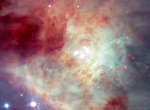 Fast Stars and Rogue Planets in the Orion Nebula
Fast Stars and Rogue Planets in the Orion Nebula
20.03.2017
Start with the constellation of Orion. Below Orion's belt is a fuzzy area known as the Great Nebula of Orion. In this nebula is a bright star cluster known as the Trapezium, marked by four bright stars near the image center.
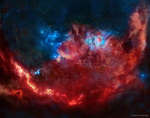 Orion in Red and Blue
Orion in Red and Blue
13.10.2018
When did Orion become so flashy? This colorful rendition of part of the constellation of Orion comes from red light emitted by hydrogen and sulfur (SII), and blue-green light emitted by oxygen (OIII). Hues...
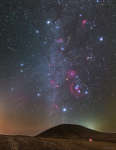 Orionids Meteors over Inner Mongolia
Orionids Meteors over Inner Mongolia
29.10.2018
Meteors have been shooting out from the constellation of Orion. This was expected, as October is the time of year for the Orionids Meteor Shower. Pictured here, over two dozen meteors were caught in successively added exposures last October over Wulan Hada volcano in Inner Mongolia, China.
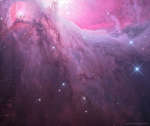 M43: Orion Falls
M43: Orion Falls
11.12.2018
Is there a waterfall in Orion? No, but some of the dust in M43 appears similar to a waterfall on Earth. M43, part of the Orion Molecular Cloud Complex, is the often imaged but rarely mentioned neighbor of the more famous M42.
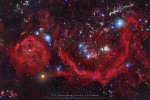 The Orion You Can Almost See
The Orion You Can Almost See
20.08.2019
Do you recognize this constellation? Although it is one of the most recognizable star groupings on the sky, this is a more full Orion than you can see -- an Orion only revealed with long exposure digital camera imaging and post-processing.
|
January February March April May June July |
|||||||||||||||||||||||||||||||||||||||||||||||||